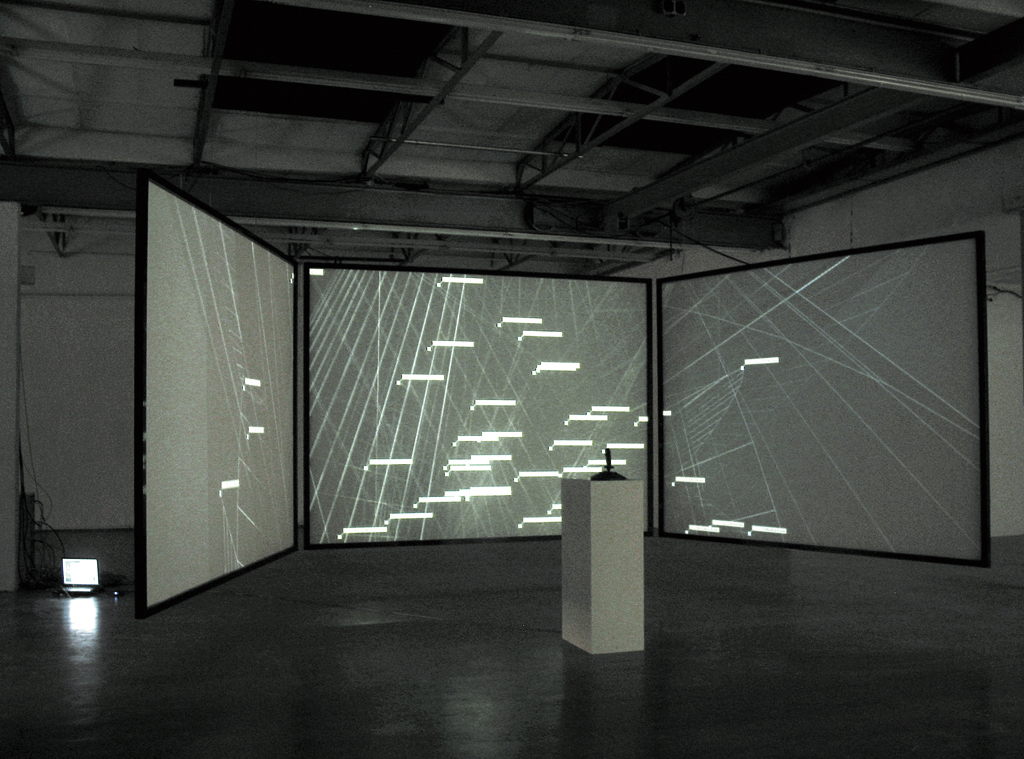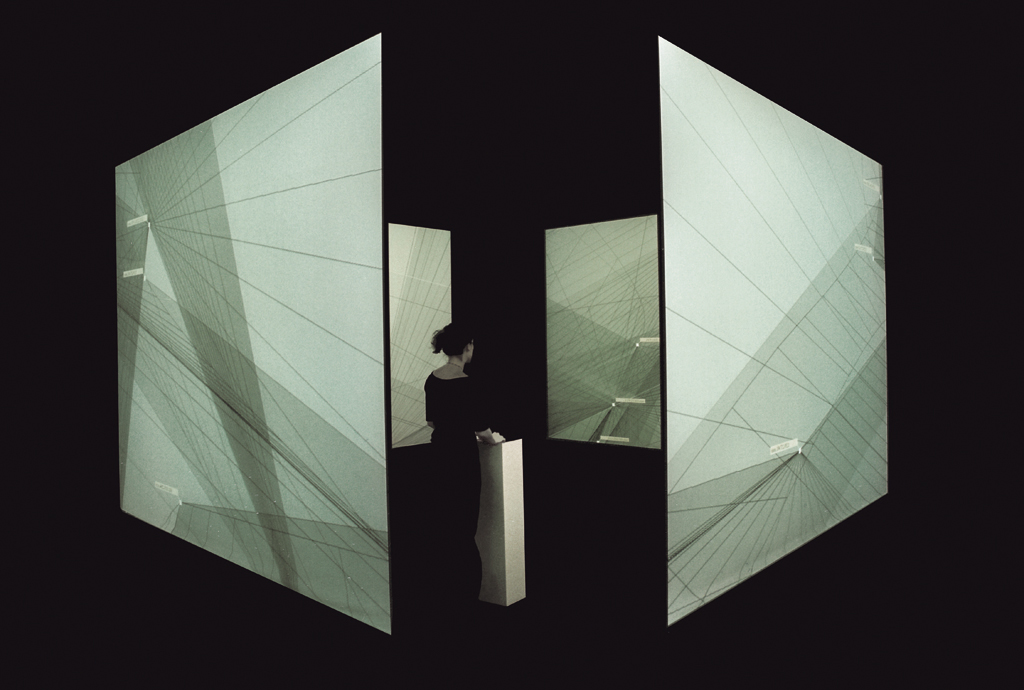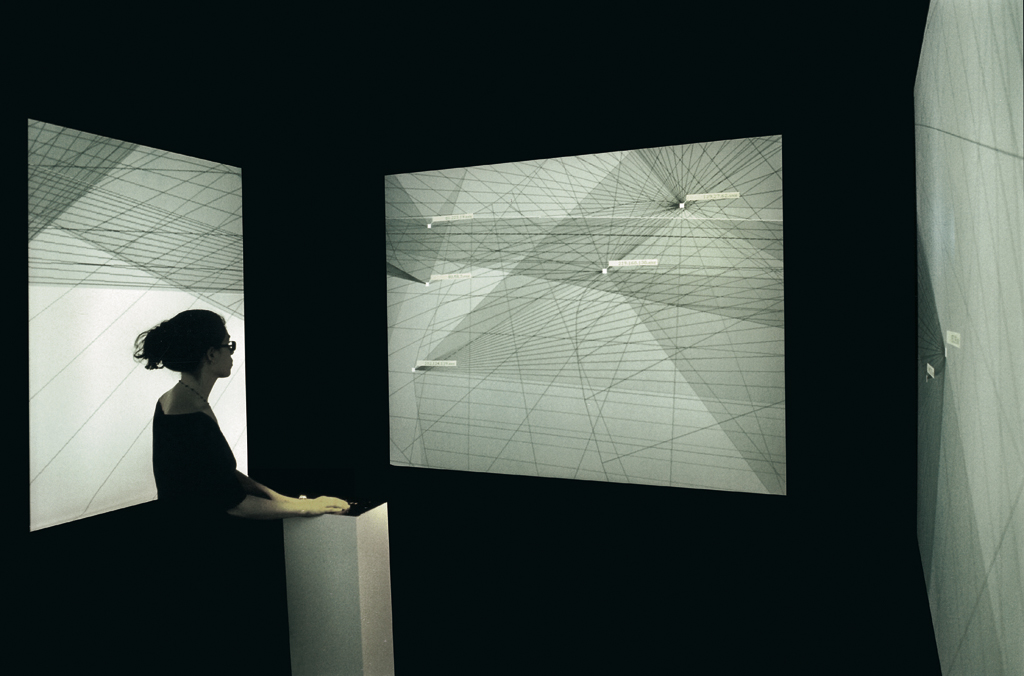IP-III
3 or 4 channel projection, 6 x 6 m, 2003
Sound composition: Echelon aka Dieter Kovacic
In collaboration with Rainer Mandl, Sepp Deinhofer and Michael Aschauer

© Exhibition view Chrono-Files, Lothringerhalle 13, Munich, 2003
[Transgressive Architecture]
The net-based media installation IP-III focuses on the fundamental extension of concepts of space and geography caused by the spread of the Internet in the late 20th century. As a design for an approach to the inner-life of electronic landscapes, IP-III opens the view to the topology of the Internet as an algorithmically built and dynamically structured surface for activity whose virtual architecture is perma-nently being altered by the continuous stream of signals. The global establishment of such a formation of alternating currents, nodes, and bundles of numerically encompassed units of data—sometimes conceived of as an open network with a large number of multiple docking points (the Internet) and sometimes as cybernetic space (cyberspace)—triggers a sustainable discursive shift in the notion of systems of local references. These were traditionally rooted in fundamental terms of Euclidean geometry or the dispositif of the central perspective, while by means of the Internet a virtual system of alternating multilaterally linked condensations was created.
In the course of the intensification of the human-machine relation-ship through the integration of continually new digital information technology in everyday life, these radical alterations in perception appear to slip gradually from view. While in the endogenous zones of the Internet, unremitting close relationships are produced via monitors and speakers with packets of data on distant servers or suggestive relationships to existing places and people somewhere out there, this perfectioning of digital communication begins to divert attention from the radical breach with usual notions of topography.

© Exhibition view O.K spektral 2, O.K Centrum für Gegenwartskunst, Linz, 2003.
Photo: Otto Saxinger
The paradigm shift already began with the emergence of modernism. In general it is marked by phenomena of dislocation. László Moholy-Nagy reflected on this with Telefonbild EM 1 in 1922, which is considered the very first realtime media artwork. It was completed per telephone communication with the head of department at a sign factory, who applied patterns of paint to graph paper exactly according to instructions. This was the expression of the realisation of an artistic concept via the conveyance of data using technology. Although in its linearity, this form of information transfer remained an isolated episode. A change of scene occurred in the course of the development of analogue media like the telephone or the radio up until the global implementation of the Internet. Processes of communication can no longer be described as currents through predetermined channels, but can be regarded as fractal architectures of changing relays, whose immanent topology is in a constant state of flux and characterised by internal docking manoeuvres and changing nodes.
Of course, a dynamism manifests itself in this radical shift where different cultural, economic, and socio-political alignments encoun-ter one another, yet the shifting of information exchange processes in the cartography of the Internet results in a new spatial practise. Temporary interfaces, agglomerations, and condensations occur while the routes taken by packets of data change or overlap without a fixed geometry. For this phenomenon of a real (because they are numerically and technologically definable) and at the same time virtual (because they cannot be fixed in terms of time and space) multidimensional architecture, Annja Krautgasser developed a variable presentation format with the installation IP-III. As a dispositif of cybermapping, IP-III also engages with a key issue in cybernetics and computer science, too, regarding the depiction of the behaviour of quantities of data and the interrelationship between algorithmic structures.
IP-III is situated in the field of interactive online projects and connects with both media-reflective discourses in the field of art and visionary concepts for deconstructivist architecture which aimed, through their attempts to overcome modern serial cubature, to reflect the onsetting instability of the grammar of spatial structures visibly and iconically. In the continuation of a project initially accessible online per monitor, Annja Krautgasser reorganised and extended IP-III for different exhibition displays as walk-in transmedial installations consisting of several projections influenced by the Internet and wired to electronic sound.

© Exhibition view O.K spektral 2, O.K Centrum für Gegenwartskunst, Linz, 2003.
Photo: Otto Saxinger
As a result of the process of graphical abstraction linked with the option for virtual navigation through the installation using a track-ball, in digital zoom, IP-III depicts the digitally recorded tracks that Internet users leave in the form of their IP addresses when they log-in to either the websites of the relevant exhibition venues or to the IP-III homepage. These digital tracks are collected and synchronised visually and acoustically in realtime. With the Internet Protocol (IP), every computer writes its numerical identity online as a Log file consisting of a 32-digit binary number. IP-III visualises this in the form of “flags” with the appropriate IP addresses. Alongside the key information, from which location and with which computer the users are accessing the web, Log files can accumulate complex data that automatically documents the user’s online behaviour.
Led by commercial interests, using this basis, high-traffic sites record users’ local parameters to compile sociographic behavioural diagrams. IP-III has a different orientation here, and reflects instead the multilaterally constructed architecture of the Internet itself. The installation that corresponds with movements in the Internet—which Annja Kratgasser developed with Rainer Mandl, Josef Deinhofer, and Michael Aschauer, and then linked with a sound concept by Dieter Kovacic (aka Echelon) for the O.K spektral, a series of electronic music events at the O.K Centrum für Gegenwartskunst in Linz—reflects the swing of spatial perception towards a multi-perspectival hybrid that defines itself through clusters of nodes and interfaces and shifts away from linear limitations. Gilles Deleuze and Felix Guattari interpreted this in Mille Plateaux as a mix of meandering segmentary systems, which in the sphere of the Internet is processualised via binary links. That the installation IP-III, as a three-dimensional visualisation of an architecture of transgression (with different forms of production generated by the digital matrix: locally on the computer as well as networked online), was linked to a dynamic structure of electronic sounds that also correlated with the permanent changes of the access data per Internet strengthened the utopian moment of a dynamic formation that is completely open. Before the background of the emancipation of sounds from their traditional systems of notation by the discourse of the avant-garde in the context of electronic music, by integrating the acoustic space, IP-III models a sensually perceptible field of unrepeatable, sign-like condensations on different levels, which Marshall McLuhan called “Resonance.” In resonance relationships, different poles correspond with one another according to processes that are not always predefinable. As in the treatment of the Internet in its endogenous zones, the perception occurs both according to principles of causality as well as in the pursuit of unpredictable sensual motifs.
(Roland Schöny)
DeutschEnglish
Exhibitions: • The Chrono-Files, Lothringerhalle 13, München/Munich, D 2003 • O.K spektral 2, OK Centrum für Gegenwartskunst, Linz, A 2003 • coord(), Kunstverein Medienturm, Graz, A 2003 • Postmediale Kondition, Neue Galerie Graz am Landesmuseum Joanneum, Graz, A 2005 • Conditiòn Postmedia, MediLab Madrid/Arco, Centro Cultural Conde Duque, Madrid, E 2006 • The Postmedia Condition, ArtNetLab/12th international festival of computer art, Mesna Galeria, Ljubljana, SLO 2006 Festivals: • FCMM, Montral, CDN2002 • Transmediale 02, Berlin, D 2003 • Viper 03 – Internationales Medienkunstfestival, Basel, CH 2003
Supported by:



No: 03-001